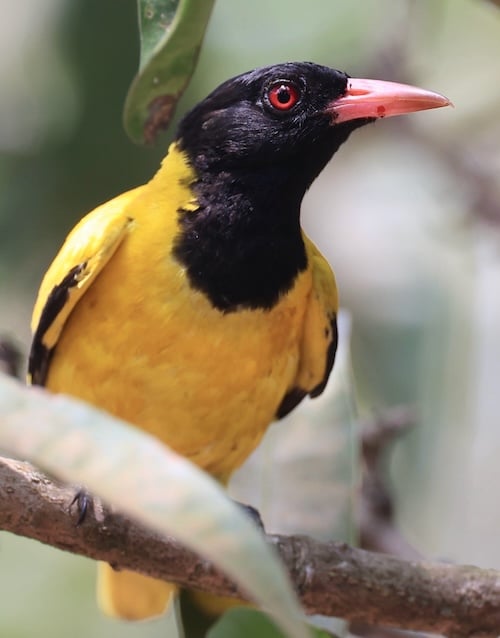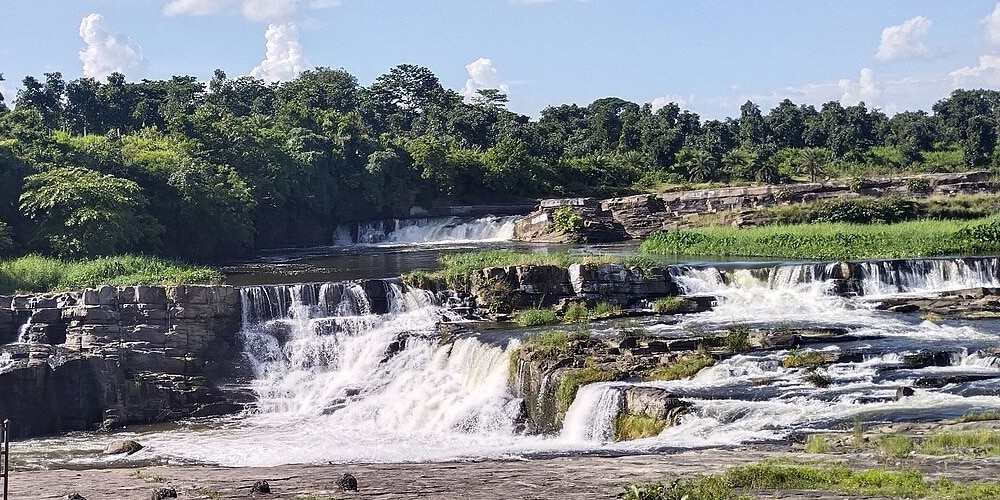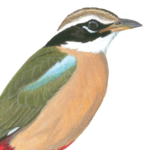Jharkhand

Jharkhand (literally ’the land of forests’) is a state in eastern India. The state shares its border with the states of West Bengal to the east, Chhattisgarh to the west, Uttar Pradesh to the northwest, Bihar to the north and Odisha to the south. It is the 15th largest state by area covering 79,716 km2 (30,779 square miles), and the 14th largest by population with over 40 million people. Hindi is the official language of the state. The city of Ranchi is its capital although several other cities are larger and Dumka is its sub-capital. The state is known for its waterfalls, hills and holy places; Baidyanath Dham, Parasnath, Dewri and Rajrappa are major religious sites. Jharkhand is primarily rural, with only about a quarter of its population living in cities.
The holy river Ganga passes through the north-eastern district of Sahebganj. There are many other significant rivers including the Sone, Subarnarekha, Kharkai, Damodar, Koel, Lilajan, Ajay, Mayurakshi and Barakar Rivers. Much of Jharkhand lies on the Chota Nagpur Plateau, with many rivers passing through it. The higher watersheds of these rivers stretch out within the Jharkhand state. Much of the state is still covered in forest, which sustains a population of elephants and tigers.

Bhatinda Falls – ©Bpagla CC BY-SA 4.0 via Wikimedia Commons
Jharkhand suffers from what is sometimes termed a resource curse: it accounts for more than 40% of India’s mineral production but the same percentage of its population is below the poverty line and a lot of children under five years of age are malnourished.
The climate of Jharkhand varies from humid subtropical in the north to tropical wet and dry in the south-east. The main seasons are summer, rainy, autumn, winter and spring. The summer lasts from mid-April to mid-June. May, the hottest month, is characterised by daily high temperatures around 37 °C and lows of around 25 °C. The southwest monsoon, from mid-June to October, brings nearly all the state’s annual rainfall, which ranges from about 40 inches in the west-central part of the state to more than 60 inches in the southwest. Nearly half of the annual precipitation falls in July and August. The winter season lasts from November to February. The temperatures in Ranchi in December usually vary from 10–24 °C. Spring lasts from mid-February to mid-April.
Birding Jharkhand
Jharkhand has a rich variety of flora and fauna. There are several wildlife sanctuaries and national park in the state, including Hazaribag Wildlife Sanctuary, Dalma Wildlife Sanctuary, Koderma Wildlife Sanctuary, Lawalong Wildlife Sanctuary, Palkot Wildlife Sanctuary, Mahuadanr Wolf Sanctuary, Palamu Tiger Reserve and Betla National Park.

Dalma Wildlife Sanctuary – ©Joydeep 87 CC BY-SA 4.0 via Wikimedia Commons
Betla National Park (Palamu), 25 km from Daltonganj covers an area of about 250 square kilometres. The national park has a wide variety of wildlife including tigers, wolves, elephants, gaurs, sambhars and hundreds of wild boar. In addition, there are large pythons and herds of spotted deer, rhesus, blue bull, porcupine, hare, wild cats, honey badgers, jackals, Malabar giant squirrel, mongoose, etc. This variety and diversity of flora and fauna has benefited from the park becoming part of Project Tiger Reserve The fauna including more than 170 bird species.
The Hazaribagh Wildlife Sanctuary, with very beautiful scenery, 135 km from Ranchi, has an ecosystem very similar to Betla National Park of Palamu.
-
Wikipedia
GNU Free Documentation License
https://en.wikipedia.org/wiki/Jharkhand
-
Number of bird species: 502
(As at June 2025)State Bird - Asian Koel Eudynamys scolopaceus
-
Avibase
PDF ChecklistThis checklist includes all bird species found in Jharkhand , based on the best information available at this time. It is based on a wide variety of sources that I collated over many years. I am pleased to offer these checklists as a service to birdwatchers. If you find any error, please do not hesitate to report them. -
Bubo Birding
ListThis checklist includes all species that have been reported in Jharkhand in eBird, but updated to IOC taxonomy, together with the likelihood of seeing each species for each month of the year. -
E-Bird
PDF ChecklistThis checklist is generated with data from eBird (ebird.org), a global database of bird sightings from birders like you. If you enjoy this checklist, please consider contributing your sightings to eBird. It is 100% free to take part, and your observations will help support birders, researchers, and conservationists worldwide.
-
Birds of the Indian Subcontinent
| By Richard Grimmett, Carol Inskipp & Tim Inskipp | Helm | 2025 | Edition 2 | Paperback | 544 pages, 240+ plates with colour illustrations; colour distribution maps, b/w illustrations | ISBN: 9781472984777 Buy this book from NHBS.com

Birds of the Indian Subcontinent
Apple iOS | AndroidThe eGuide to Birds of the Indian Subcontinent is an interactive companion to Birds of the Indian Subcontinent – the definitive guide for birdwatchers visiting the region. It covers India, Pakistan, Nepal, Bhutan, Bangladesh, Sri Lanka and the Maldives. This application has specific features that will enhance your birding experience.
Indian Birds
Apple iOS | AndroidPioneers in bringing Indian Birding to the smart phone generation - Introducing Indian Birds, the time-honoured and cherished birding companion for India. Established in 2010, it proudly remains the sole mobile app available on App Store, offering bird enthusiasts the ability to explore bird namesUseful InformationReserves-
*Wildlife Sanctuaries in Jharkhand
InformationSatellite ViewThis Indian state is home to a variety of national parks and wildlife sanctuaries, which are teeming with exotic animals and birds... -
NP Betla
InformationSatellite ViewInitially comprising 1,026 km2 (396 sq mi) of the Palamu Tiger Reserve, an additional 226 km2 (87 sq mi) was added to the park in 1989 and 63 km2 (24 sq mi) of the Mahuadar wolf sanctuary.[1][2] Betla was one of the first national parks in India to become a tiger reserve under Project Tiger. The park has a variety of diverse eco-systems and abundance of wild animals. Elephants in large numbers are seen mostly between the end of the monsoon season, to the time when watering holes begin to dry in March. Birds include the hornbill, peafowl, red jungle fowl, black partridge, white-necked stork, black ibis, swamp grey, quail, pied hornbill, wagtail, harial, dove, drongo, crested serpent-eagle, forest owlet, papeeha, and other birds usually found in dry deciduous forests. The Kamaldah lake attracts several varieties of water birds including the common whistling, cotton teal, knob-billed duck, snipe and geese. -
WS Dalma
InformationSatellite ViewDalma Wildlife Sanctuary is located 10 km from the city of Jamshedpur and contains significant population of Indian Elephants. The sanctuary covers around 195 km2. Beside elephants there are Indian giant squirrel, sloth bear, barking deer, wild boar, porcupine, mouse deer, pangolin and mongooses in the sanctuary. Commonly seen birds in the sanctuary are the falcons, golden oriole, Indian tree pie, paradise fly catchers, grey hornbills, Indian peafowl, different varieties of king fishers, herons, egrets, mynas, pigeons, racket tailed drongo, magpie robins etc. -
WS Gautam Budha
InformationSatellite ViewLocated in Gaya district of Bihar state and Koderma district of Jharkhand state and covers an area of 259 km2. Prior to becoming a wildlife refuge, the area was a private hunting reserve. Fauna include tigers, leopards, wolves, sloth bears, chitals, chinkaras, and many species of birds. -
WS Hazaribag
InformationSatellite ViewNestling in low hilly terrain, at an average altitude of 615 metres (2,018 ft), it has an area of 184 km2 (71 sq mi) and is home to sambar, nilgai, chital, peafowl, sloth bears, black bears & hyenas.
Sightings, News & Forums-
eBird
SightingseBirding This Month
Blogs-
Prabhat Kumar Thakur - Birds of Jharkhand
BLOGPhotoblog
Photographers & Artists-
Birds of Jharkhand
PhotographsPhot BLOG
Fatbirder - linking birders worldwide...
Skip to content
